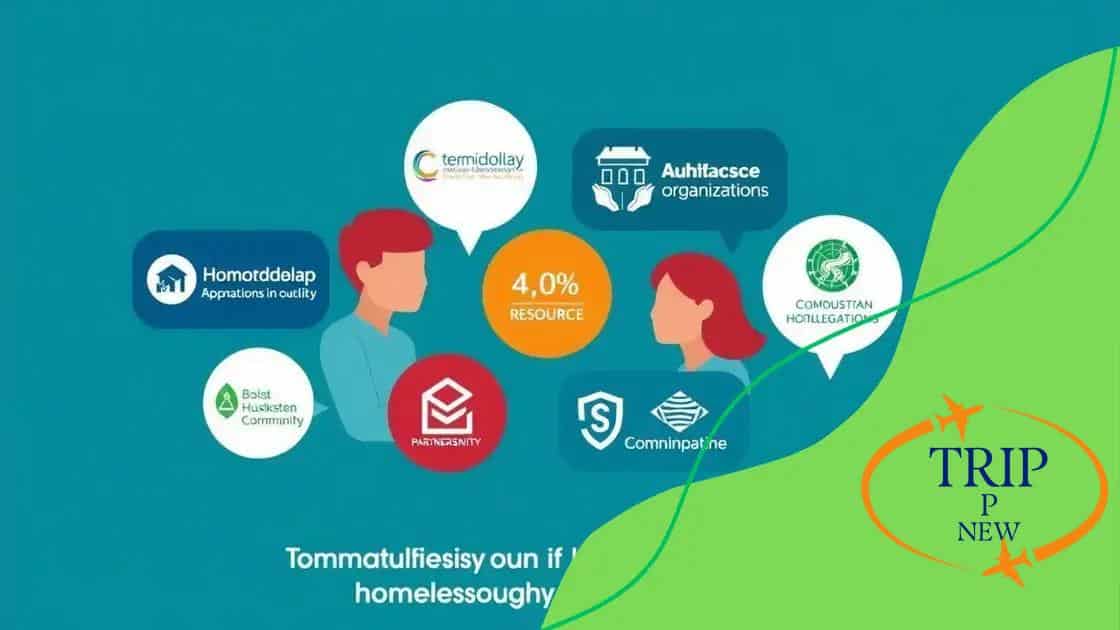Homelessness prevention initiatives: ways to make a difference

Anúncios
Homelessness prevention initiatives are essential strategies that provide support, resources, and stable housing to individuals and families at risk of homelessness, fostering community collaboration and effective policies.
Homelessness prevention initiatives are essential for fostering stability in our communities. By learning about these strategies, you might find ways to contribute or support those in need.
Anúncios
Understanding the root causes of homelessness
Understanding the root causes of homelessness is crucial for developing effective prevention strategies. Many factors contribute to this complex issue. By examining these causes, communities can address the challenges more effectively.
Economic Factors
Economic instability is one of the leading causes of homelessness. When individuals or families face job loss, unexpected expenses, or financial crises, they may struggle to maintain stable housing. This instability often leads to a cycle of homelessness that is hard to break.
Social Issues
Social challenges such as mental illness and substance abuse significantly impact homelessness rates. Individuals dealing with these issues often face stigma and can have difficulty accessing necessary support services. Creating a supportive environment is essential.
Anúncios
- Access to mental health services can aid recovery.
- Substance abuse programs offer recovery pathways.
- Community support initiatives encourage reintegration into society.
Moreover, the lack of affordable housing is a pressing concern. Many cities experience a housing crisis where rents are soaring, yet wages remain stagnant. This disparity forces families to choose between essential needs, often pushing them into homelessness.
Additionally, systemic barriers such as discrimination can exacerbate the situation. Minorities and marginalized groups frequently face challenges that make it more difficult for them to secure stable housing. Addressing these barriers is crucial to finding lasting solutions.
Personal Circumstances
Personal circumstances, including family disputes, domestic violence, and health issues, can abruptly thrust individuals into homelessness. Victims of domestic violence often flee their homes without a safety net, leaving them vulnerable and without resources.
- Supporting shelters can provide safe spaces.
- Legal assistance helps protect victims’ rights.
- Rapid rehousing programs offer financial resources.
Recognizing these root causes of homelessness helps communities tailor their responses effectively. Solutions must be multifaceted, considering both the individual and systemic barriers that contribute to this urgent issue.
Effective outreach strategies for at-risk populations
Effective outreach strategies for at-risk populations are essential in preventing homelessness. These strategies aim to connect vulnerable individuals and families with necessary resources and support systems.
Building Trusting Relationships
Creating rapport with at-risk communities is vital. Trust allows outreach workers to engage meaningfully with individuals who may be skeptical of assistance. This relationship-building can start by attending community events and being present in local spaces.
Utilizing Local Resources
Collaborating with local organizations enhances outreach efforts. By leveraging established relationships with shelters, food banks, and healthcare providers, outreach programs can create a network of support.
- Establish regular meetings with local shelters to share resources.
- Partner with healthcare providers to offer health screenings.
- Connect individuals with educational programs for skill development.
Regularly distributing information about available services helps keep the community informed. Flyers, social media campaigns, and word-of-mouth can effectively raise awareness. It’s important for outreach initiatives to use clear language and visuals that resonate with the target audience.
Another important aspect of outreach is using mobile units. These units can travel to areas where individuals are most in need, providing immediate assistance and services. This approach ensures that help reaches those who may not seek out resources on their own.
Incorporating Feedback
Listening to the community is crucial for continuous improvement. Gathering feedback helps programs adapt their strategies to better meet the needs of at-risk populations. Surveys, focus groups, and informal discussions can provide valuable insights.
- Implement a feedback system that is easy for clients to use.
- Adjust strategies based on community input and changing needs.
- Incorporate success stories to motivate and inspire.
Lastly, training volunteers and staff in cultural competence is essential. Understanding the unique backgrounds and experiences of at-risk populations leads to more effective and compassionate outreach.
Collaborative models for community resources

Collaborative models for community resources play a vital role in effectively addressing homelessness. These models bring together various stakeholders to combine their strengths and resources, making a more significant impact.
Building Partnerships
Successful collaboration starts with building strong partnerships. Local governments, non-profits, businesses, and community members should work together to address homelessness. By pooling resources, the community can create comprehensive support systems.
Resource Sharing
Resource sharing is essential in collaborative models. Different organizations can contribute their strengths, such as:
- Funding for programs from local businesses.
- Volunteers from faith-based organizations.
- Space provided by community centers for meetings and support services.
This sharing of resources can enhance the overall effectiveness of the initiatives. When organizations understand each other’s missions, they can create targeted programs that meet the specific needs of individuals experiencing homelessness.
Another aspect of collaboration involves coordinated services. By offering a one-stop-shop approach, services become more accessible. For example, individuals can receive mental health support, job training, and housing assistance in one location. This efficiency can significantly aid in stabilizing at-risk populations faster.
Engaging the Community
Engaging the community in collaborative efforts is crucial. Local residents often have valuable insights into the unique challenges faced by their neighborhoods. This local knowledge can guide outreach programs and resource allocation.
- Hold community meetings to discuss challenges and solutions.
- Foster an environment where everyone feels heard and valued.
- Encourage local participation in volunteer activities and resource drives.
Additionally, using data-driven approaches enhances collaboration. Tracking success metrics, such as the number of individuals moved into stable housing or how many accessed resources, helps refine strategies. This data allows stakeholders to see what works and adapt their approach accordingly.
The role of policy in homelessness prevention
The role of policy in homelessness prevention is critical. Effective policies can create a framework that supports individuals at risk and addresses the root causes of homelessness. Policymakers must collaborate with community organizations to develop strategies that are practical and inclusive.
Creating Supportive Legislation
Supportive legislation is essential in preventing homelessness. Laws that promote affordable housing can make a significant difference. By ensuring there are sufficient low-income housing options, we can reduce the number of people at risk of becoming homeless.
Funding and Resources
Government funding is another vital aspect. Adequate financial resources must be allocated to programs that assist those experiencing or at risk of homelessness. These funds can support shelters, mental health services, and job training programs.
- Investing in housing-first initiatives provides immediate stability.
- Supporting mental health resources helps address underlying issues.
- Funding job training programs can enhance employment opportunities.
Policies should also focus on preventing eviction. Legal protections for tenants can provide the necessary safeguards against losing their homes. Providing rental assistance programs helps keep families stable and in their homes.
Collaboration with Nonprofits
Collaboration between government agencies and non-profits improves the effectiveness of homelessness prevention efforts. These partnerships can lead to innovative solutions and resource sharing. Non-profits often have direct contact with the community, giving them insights into the unique needs that policies must address.
- Coordinating efforts ensures more comprehensive service delivery.
- Non-profits can provide feedback on policy effectiveness.
- Community organizations can educate the public about available resources.
Lastly, public awareness campaigns can help inform citizens about homelessness issues. Educating the community fosters empathy and encourages support for local initiatives.
Success stories from impactful initiatives
Success stories from impactful initiatives can showcase effective solutions to homelessness. These stories highlight how communities can make a difference in the lives of vulnerable individuals.
Case Study: Housing First Programs
The Housing First model has seen remarkable results in various cities. By providing stable housing without preconditions, many individuals have found a path to recovery. Once housed, people can access necessary services like mental health support and job training.
Community Partnerships
In several regions, strong community partnerships have played a vital role in tackling homelessness. Local governments collaborated with non-profits and faith-based organizations to create holistic support networks. These partnerships often lead to innovative solutions.
- Job training programs have helped individuals secure stable employment.
- Shelter facilities offer comprehensive health services.
- Community events foster a sense of belonging, reducing isolation.
Another example is a program that provides mentorship for at-risk youth. By connecting them with positive role models, these youths gain the skills and confidence they need to thrive. Many have successfully transitioned into stable housing and completed their education.
Additionally, a local initiative focused on families has transitioned many individuals out of shelters. By offering rental assistance and financial education, families can maintain stable housing and avoid future crises.
Outcome Metrics
Measuring success is essential for these initiatives. Programs that document outcomes, such as reduced recidivism rates and improved mental health, provide valuable insights. Stakeholders can use this data to refine their approaches and share best practices.
- Regularly assess program effectiveness to identify successful methods.
- Share results with community members to foster support.
- Invite feedback to continually improve services.
These success stories demonstrate the potential for communities to create lasting change. By investing in resources, collaboration, and innovative models, we can address the challenges of homelessness effectively.
FAQ – Frequently Asked Questions about Homelessness Prevention Initiatives
What are homelessness prevention initiatives?
Homelessness prevention initiatives are programs and strategies designed to provide support and resources to individuals and families at risk of becoming homeless.
How can community collaboration help in preventing homelessness?
Community collaboration combines resources and expertise from various organizations, leading to more effective solutions and a comprehensive support system for those in need.
What is the Housing First model?
The Housing First model prioritizes providing stable housing to individuals without preconditions, allowing them to access support services while having a secure place to live.
How can I get involved in local homelessness prevention efforts?
You can get involved by volunteering with local non-profits, attending community meetings, or donating to organizations that support homelessness prevention initiatives.





